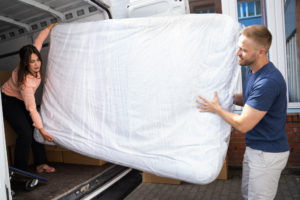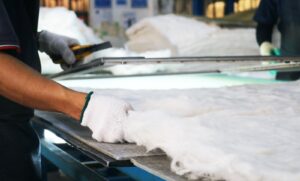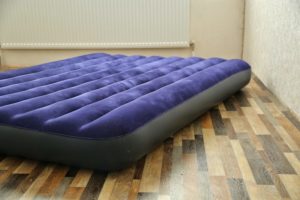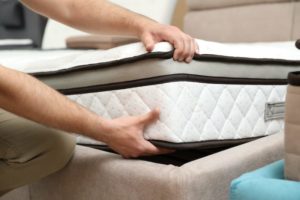Signs You Have Fleas in Your Bed
- Fleas usually enter the home on pets that pick them up when they go outside.
- Flea bites can be itchy and bothersome to pets and humans.
- Getting rid of fleas in and around your bed requires treating the pet, washing all bedding, and vacuuming frequently.
- It is imperative to remove flea eggs, larvae, and pupae so that no new fleas can emerge.
When a person wakes up with itchy bites on their skin, they may wonder what’s hiding in their bed. Fleas are one possible cause of these red spots, especially if there is a pet in the house.
Fleas are parasites that feed on the blood of animals, including pets and humans. They are tiny, with the species most commonly found on cats and dogs measuring about 1 to 4 millimeters long. Fleas don’t have wings, but they can jump far because of their strong hind legs.
We’ll discuss the telltale signs you have fleas in your bed, how they get there, the best way to get rid of them, and how to keep fleas away for good.
Is Your Troubled Sleep a Health Risk?
A variety of issues can cause problems sleeping. Answer three questions to understand if it’s a concern you should worry about.
How Fleas Get Into the Bedroom
Adult fleas usually get into a person’s bed by way of a dog or cat who sleeps or spends a lot of time on the bed. When pets go outside, fleas can attach to them, start to feed, and come back into the home along with the pet.
Fleas can also be brought indoors on a human, especially if the person has been in a heavily wooded area. Used furniture or rugs are other possible sources of fleas.
Although live adult fleas can get into a person’s bed by way of their pet, it’s more common to find white flea eggs in your bedding. This is because within 24 hours of starting to feed, adult fleas mate and females start laying about 40 to 50 eggs per day, which can easily fall off a pet.
How Long Fleas Can Live in Bedding
Flea eggs, which measure approximately 0.5 millimeters long, can live in bedding for 1 to 10 days until they hatch into larvae. Flea larvae can survive as long as a flea-infested pet is nearby, since the larvae feed on the feces of adult fleas, known as “flea dirt.” The larvae develop into pupae within 5 to 20 days.
Flea pupae remain in their cocoon until a food source is available. They can live up to five months without a meal, waiting to emerge as an adult flea when there is a host to feed on.
Flea populations continue to reproduce if they have a food source. They tend to flourish in warm and humid conditions. Fleas that have mated tend to die within two days if removed from their food source, though some can live longer under optimal conditions.

How Fleas Can Be Harmful
Fleas can spread germs and diseases, including flea-borne typhus and cat scratch disease. Pets with fleas may scratch, bite, or lick flea bites, often developing red, scaly patches of skin or losing hair. In extreme cases, a pet may develop anemia because of the blood loss caused by the feeding fleas.
Flea bites are itchy and uncomfortable for humans as well. Bites that are scratched too much can become infected. Someone who is very allergic to flea saliva may break out in a rash from the bites.
Signs of Fleas in Your Bed
The first sign of fleas in your bed may be waking up with itchy bites on your skin. If fleas fall off a pet and land in the bed, they may bite humans if the pet is not nearby. For some people who aren’t sensitive to flea bites or don’t sleep with their pet, the first sign of fleas is a pet’s constant scratching.
Bites
Flea bites on a human appear as small bumps that can be red and itchy. Often, there are several bites in a row or cluster. Flea bites can be anywhere on the body, but usually they are seen on the feet and lower part of the legs.
‘Flea Dirt’ (Residue)
Flea dirt or residue is the waste product left behind after fleas feed. Flea dirt looks like little black pepper flakes. You might see flea dirt on your pet if you look closely under their fur. You can also use a fine-toothed flea comb to carefully brush your pet’s fur and identify fleas or flea dirt. Flea dirt can also be found in bedding, on furniture, or in carpets.
Even if you don’t see adult fleas, flea dirt is a sign that they have been there. If you’re not sure if you’ve found flea dirt, rub it on a damp paper towel. If it turns red, that’s a sign that it’s from fleas.
Pet Scratching
When a pet goes outside, fleas in the grass or on other animals can attach to them and start feeding. Scratching, biting, or intense grooming are signs that the pet has fleas in its fur.
Like humans, pets have varying sensitivities to flea saliva. Some won’t be affected much, while others will develop scabs, rough skin spots, or hair loss from the irritation and itching.
Flea Eggs and Skin
Flea eggs are harder to see than adult fleas or flea dirt because they are white and are about the size of a grain of salt. While flea eggs can be found on pets, you’re more likely to see these oval-shaped eggs where they’ve been dropped, like on bedding, floors, or furniture.
How to Get Rid of Fleas in the Bed
Treating a bed that’s infested with fleas is a multistep process that usually needs to be repeated to ensure all life stages of the fleas are gone.
- Treat the pet: Speak with your veterinarian about treatment options if you suspect your pet has fleas. They may recommend flea medication or a flea collar. If you have multiple pets and one has fleas, it’s a good idea to wash all of them, even ones that aren’t scratching or don’t sleep in your bed. Use a flea comb to check for any surviving fleas in the fur. Drop the fleas into a bucket of hot, soapy water and flush them down the toilet.
- Wash all bedding: Take all bedding off the mattress, including sheets, pillowcases, blankets, comforters, and mattress pads. If the care instructions permit, wash them in hot water and tumble dry. Repeat this process at least once a week until all signs of fleas on your pet and in your home are gone. If your pet has its own bed, wash that bedding as well.
- Vacuum frequently: Vacuum the mattress as well as the floor and carpet surrounding the bed. Clean all the seams and corners of the mattress using a crevice vacuum tool and don’t forget to vacuum the side and bottom of your mattress. When you are done, take the vacuum bag outside to the trash right away, or empty the bagless vacuum canister into the outside trash and wash the canister thoroughly with hot, soapy water.
- Use a steam cleaner: Steam clean carpets, floors, and furniture, since the high heat can help kill fleas at all life stages. Before steam cleaning a mattress, check the mattress label or manufacturer website to see if it is safe to do so.
- Use an insecticide: If you have a large flea infestation, you may need to use an insecticide or consider hiring a professional pest control service to fully address the problem.
How to Prevent Fleas From Reappearing
You can most effectively prevent fleas from getting into your bed by keeping fleas off you and your pet. Ask your veterinarian for a product recommendation for a year-round flea preventative for your pet.
If you have a pet, regularly vacuum all areas of your home and wash any bedding and blankets they may come into contact with. A mattress encasement can help keep fleas and flea dirt away from your mattress.
Flea prevention products that may help keep fleas away include:
- Oral medications or topical “spot-on” treatments for your pet
- Special pet shampoos
- Flea collars
- Flea sprays for your home
- Insecticide flea dust or powder for your home

Still have questions? Ask our community!
Join our Sleep Care Community — a trusted hub of sleep health professionals, product specialists, and people just like you. Whether you need expert sleep advice for your insomnia or you’re searching for the perfect mattress, we’ve got you covered. Get personalized guidance from the experts who know sleep best.









